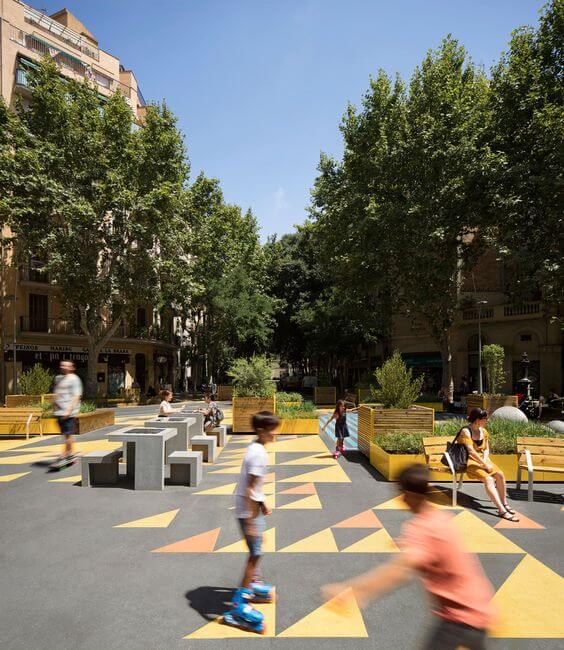Barcelona is a city known for its architectural beauty and its welcoming atmosphere. However, in recent years, the Catalan capital has gone a step further by reinventing itself in terms of urban planning. For more than 30 years at Renta Corporación we have participated in its transformation in order to adapt the buildings to the needs of the new generations, providing added value and without losing their spirit and essence.
In this Renta Insights article, we will explore some of the innovative initiatives that the city has implemented to transform its urban landscape and become a global benchmark in the field of sustainable development.
Pedestrianization of the streets – Superilla model
One of the most outstanding strategies that Barcelona has adopted is the Superilla model. This concept pursues the objective that passers-by recover a part of the space currently occupied by private vehicles. Through the pedestrianization of several city blocks, larger, greener and safer spaces have been created for pedestrians. The streets have been transformed into areas of coexistence, with priority for pedestrians and non-motorized means of transport. This approach has fostered social interaction and has improved the quality of life for residents by reducing noise and air pollution.
Adaptation of urban spaces
The city stands out for its ability to adapt its urban spaces to the changing needs of society. A clear example is the renovation of old factories and warehouses into modern cultural and residential spaces. These renovated spaces have given rise to new urban areas with a great cultural and leisure offer, attracting both residents and tourists.
As a result of the pandemic, the conception we had of our streets has drastically changed. After almost three months of home confinement, the streets ceased to be a priority space for vehicles to make way for people. Playing sports in the open air or simply meeting up with family or friends for walks or picnics was the beginning of the so-called new normality. This caused a change in the use of public spaces that showed us that the transformation of large cities like Barcelona is necessary and beneficial not only for citizens but also for the environment.
Urban planning to fight climate change
The fight against climate change has been a priority in Barcelona’s urban planning. The city has implemented measures to reduce greenhouse gas emissions, encourage energy efficiency, and promote the use of renewable energy. In addition to the Superblocks, numerous green areas have been created and the presence of trees on the streets has been increased to improve air quality and combat the heat island effect.
Green facades and urban gardens
Another urban planning initiative that stands out in more and more cities is the incorporation of green façades and urban gardens on the roofs of buildings. These green spaces not only beautify the city, but also provide environmental benefits by improving air quality, reducing temperatures, and promoting biodiversity. In addition, urban gardens allow residents to grow their own fruits and vegetables, encouraging a more sustainable and healthier lifestyle.
The future of mobility
If we talk about reinventing ourselves in terms of urban planning, we must mention the future of urban mobility.
In recent years Barcelona has facilitated accessibility to the different forms of public transport by expanding the infrastructure with new bus lines, tram lines and some of the existing metro lines. It has also encouraged the use of bicycles as an alternative way of transportation, creating extensive networks of bike lanes and shared bike systems. In addition, smart mobility solutions have been implemented, such as the integration of mobile applications for public transport and the promotion of electric mobility.
Another fundamental aspect that has contributed to this fact has been the discounts on frequently used tickets for public transport and the extension of the age of use of the T-Jove, which allows more and more citizens to opt for other ways of moving around the city. city apart from the private vehicle. These measures are helping to reduce traffic congestion and improve air quality in the city.
These transformations not only benefit the residents of Barcelona, but also attract the attention of investors and buyers interested in a city with a long-term vision and a focus on sustainability. The commitment to a more humane, green and efficient urban plan creates a favorable environment for the development of innovative real estate projects.

